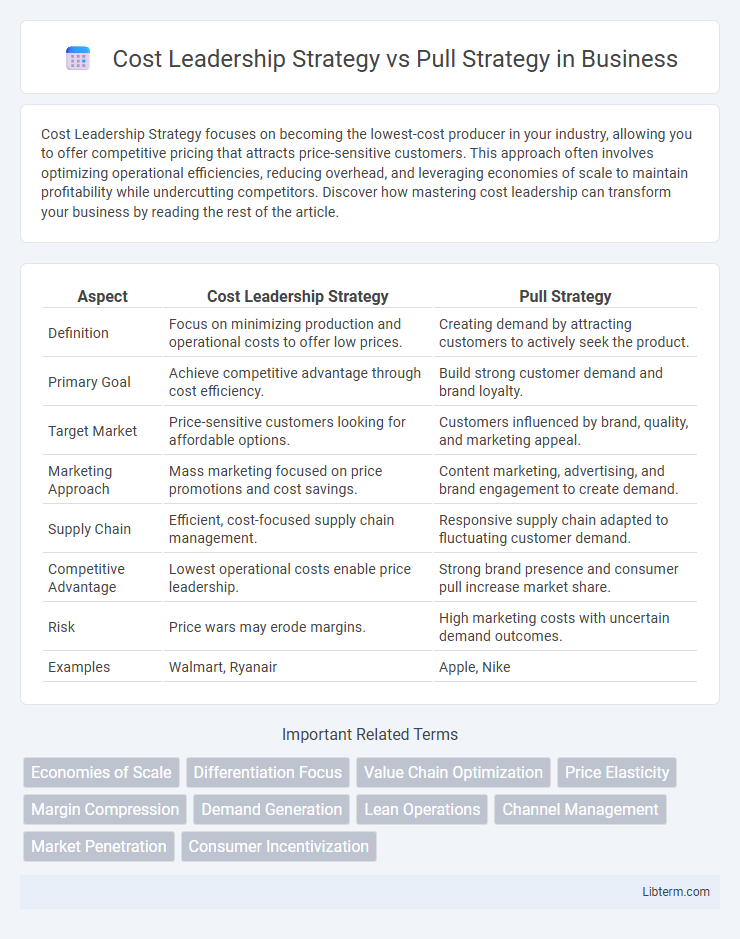Cost Leadership Strategy focuses on becoming the lowest-cost producer in your industry, allowing you to offer competitive pricing that attracts price-sensitive customers. This approach often involves optimizing operational efficiencies, reducing overhead, and leveraging economies of scale to maintain profitability while undercutting competitors. Discover how mastering cost leadership can transform your business by reading the rest of the article.
Table of Comparison
| Aspect | Cost Leadership Strategy | Pull Strategy |
|---|---|---|
| Definition | Focus on minimizing production and operational costs to offer low prices. | Creating demand by attracting customers to actively seek the product. |
| Primary Goal | Achieve competitive advantage through cost efficiency. | Build strong customer demand and brand loyalty. |
| Target Market | Price-sensitive customers looking for affordable options. | Customers influenced by brand, quality, and marketing appeal. |
| Marketing Approach | Mass marketing focused on price promotions and cost savings. | Content marketing, advertising, and brand engagement to create demand. |
| Supply Chain | Efficient, cost-focused supply chain management. | Responsive supply chain adapted to fluctuating customer demand. |
| Competitive Advantage | Lowest operational costs enable price leadership. | Strong brand presence and consumer pull increase market share. |
| Risk | Price wars may erode margins. | High marketing costs with uncertain demand outcomes. |
| Examples | Walmart, Ryanair | Apple, Nike |
Introduction to Cost Leadership and Pull Strategies
Cost Leadership Strategy emphasizes minimizing production and operational costs to offer products at the lowest prices, targeting price-sensitive customers and gaining a competitive advantage. Pull Strategy focuses on creating strong consumer demand through advertising, brand loyalty, and engagement, encouraging customers to actively seek out the product. Both strategies drive market success by either dominating through pricing efficiency or stimulating customer-driven demand.
Defining Cost Leadership Strategy
Cost leadership strategy focuses on becoming the lowest-cost producer in an industry, enabling businesses to offer products or services at competitive prices while maintaining profitability. This approach emphasizes operational efficiency, economies of scale, and cost-saving innovations to reduce expenses across production, distribution, and marketing. By achieving the lowest cost structure, companies can attract price-sensitive customers and gain a competitive advantage in price-driven markets.
Understanding Pull Strategy
Pull strategy drives consumer demand by directly targeting end users, encouraging them to actively seek products through promotional efforts and brand engagement. This approach leverages advertising, social media campaigns, and influencer marketing to build strong customer relationships and generate organic demand. Unlike cost leadership strategy focused on minimizing expenses to offer lower prices, pull strategy emphasizes creating value perceptions and stimulating consumer interest to pull products through the distribution channel.
Key Differences Between Cost Leadership and Pull Strategies
Cost Leadership Strategy centers on minimizing production and operational costs to offer competitive pricing, targeting price-sensitive customers and achieving economies of scale. Pull Strategy prioritizes creating strong consumer demand through marketing and promotion, encouraging customers to actively seek out products. Key differences include Cost Leadership's focus on internal efficiency and cost reduction versus Pull Strategy's emphasis on demand generation and customer engagement.
Advantages of Cost Leadership Strategy
Cost Leadership Strategy enables companies to achieve the lowest production and operational costs, resulting in competitive pricing that attracts price-sensitive customers and increases market share. This approach fosters economies of scale, enhancing profit margins even in highly competitive markets. By maintaining cost efficiency, firms can withstand price wars and economic downturns more effectively than those relying solely on Pull Strategy's demand-driven marketing efforts.
Benefits of Implementing Pull Strategy
Implementing a pull strategy enhances customer engagement by responding directly to consumer demand, leading to increased brand loyalty and more efficient inventory management. This approach reduces excess stock and minimizes waste by producing only what customers actively seek, optimizing operational costs. Furthermore, pull strategy fosters better market responsiveness, allowing businesses to adapt quickly to shifting consumer preferences and competitive dynamics.
Challenges in Adopting Cost Leadership Strategy
Cost Leadership Strategy faces challenges such as maintaining low production costs without compromising quality, managing economies of scale, and sustaining competitive pricing amid rising input costs. Firms struggle with innovation constraints and risk being outperformed by competitors offering differentiated products. Achieving continuous operational efficiency while addressing supplier negotiations and potential price wars presents significant obstacles in adopting this strategy.
When to Use Pull Strategy Over Cost Leadership
Pull strategy is most effective when targeting markets with strong brand loyalty and high customer involvement, as it prioritizes demand creation through advertising and promotions. This approach excels in industries with differentiated products where customers actively seek specific brands, making it ideal for premium or innovative products. Companies should favor pull strategies over cost leadership when the goal is to build brand equity and engage consumers rather than compete primarily on price.
Real-World Examples: Cost Leadership vs Pull Strategy
Cost Leadership Strategy is exemplified by Walmart, which leverages efficient supply chains and bulk purchasing to offer low prices and capture price-sensitive customers. In contrast, Pull Strategy is demonstrated by Apple, where strong branding and advertising create high consumer demand that pulls products through the distribution channel. These distinct approaches highlight how companies either drive cost advantages or stimulate customer demand to achieve competitive market positioning.
Choosing the Right Strategy for Your Business
Cost leadership strategy focuses on achieving the lowest production and operational costs to offer competitive pricing, making it ideal for businesses targeting price-sensitive markets. Pull strategy emphasizes creating strong customer demand through branding and advertising, suitable for companies with differentiated products seeking to build brand loyalty. Choosing the right strategy depends on market positioning, customer behavior, and the company's core competencies to ensure sustainable growth and competitive advantage.
Cost Leadership Strategy Infographic

 libterm.com
libterm.com